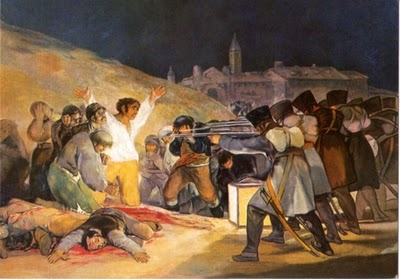The book starts in March 1808. Gabriel is working at the printing press of 'Diario de Madrid'. It was founded on February 1, 1758, so it is considered the newspaper in Spain. At first it was published under the name 'Newsworthy, Curious, Erudite, Commercial, Political and Economic Newspaper, and after changing the name to 'Diario de Madrid', it was published until May 1808 when Jose Bonaparte's government took control of the it. It was closed down on December 31, 1814.
Gabriel goes to visit Ines in Aranjuez where she is living with her uncle. Aranjuez ( is a city and municipality of Spain, part of the Community of Madrid. Aranjuez became one of the Royal Estates of the Crown of Spain in 1560, during the reign of Philip II. Until 1752, only royalty and nobility were allowed to dwell in the town.
Manuel de Godoy y Álvarez de Faria Ríos (12 May 1767, Badajoz, Spain – 4 October 1851, Paris, France), 1st Prince of the Peace, 1st Duke of Alcudia, 1st Duke of Sueca, 1st Baron of Mascalbó, was the First Secretary of State of the Kingdom of Spain from 1792 to 1797 and then from 1801 to 1808, and as such, one of the central Spanish political figures during the rise of Napoleon and his invasion of Spain.
The Royal Palace of Aranjuez is one of the official residences of the Spanish royal family. Established in the 16th century as a royal hunting lodge, the palace was built by order of Philip II. Under his reign it became one of four seasonal seats of the court along Rascafría, El Escorial and the Royal Alcázar of Madrid. The royal estate comprises a set of landscaped and ornate gardens and woodlands that house an extensive botanical collection.During Gabriel's visit he is direct witness to the Tumult of Aranjuez. The Tumult of Aranjuez was an uprising led against King Charles IV that took place in the town of Aranjuez, on 17–19 March 1808. The event, which is celebrated annually in the first week of September, commemorates the fall of the monarch and the subsequent accession of his son Ferdinand VII. It is celebrated in September rather than in March as the revived celebrations in Aranjuez that began in 1988 were added on top of pre-existing September festivals.
A mob stormed Godoy's residence, where at first they only found his mistress Pepita. Two days later, Godoy was found.
One of the French men sent to Spain was Joaquin Murat, Napoleon's brother-in-law. Joachim Murat (25 March 1767 – 13 October 1815) was a French Army officer and statesman who served during the French Revolutionary and Napoleonic Wars. Murat was in charge of the French Army in Madrid when the popular Dos de Mayo Uprising, that started the Peninsular War, broke out.
On May 2 there is an uprising against the French. The Second of May Uprising took place in Madrid, Spain, on 2–3 May 1808. The rebellion, mainly by civilians, with some isolated military action by junior officers, was against the occupation of the city by French troops, and was violently repressed by the French Imperial forces, with hundreds of public executions.
Captain Luis Daoiz y Torres (10 February 1767 – 2 May 1808) was a Spanish Army officer who was one of the leaders of the Dos de Mayo Uprising which resulted in the outbreak of the Spanish War of Independence. Daoiz returned to Madrid in 1808 and was a leader of the uprising on 2 May in which he assisted civilians resisting French efforts to forcibly relocate the Spanish royal family. His defence of the barracks at Monteleón was the only instance on that day in which the Spanish army fought the French and, although ultimately unsuccessful, it inspired a country-wide uprising against France. Daoiz died in the fighting and was subsequently commemorated as a national hero.
Pedro Velarde y Santillán (25 October 1779 – 2 May 1808) was a Spanish artillery captain famous for his heroic death in the Dos de Mayo uprisings against the French occupation of Madrid. He became a popular hero and martyr figure for Spain's subsequent War of Independence from the French Empire.













No comments:
Post a Comment